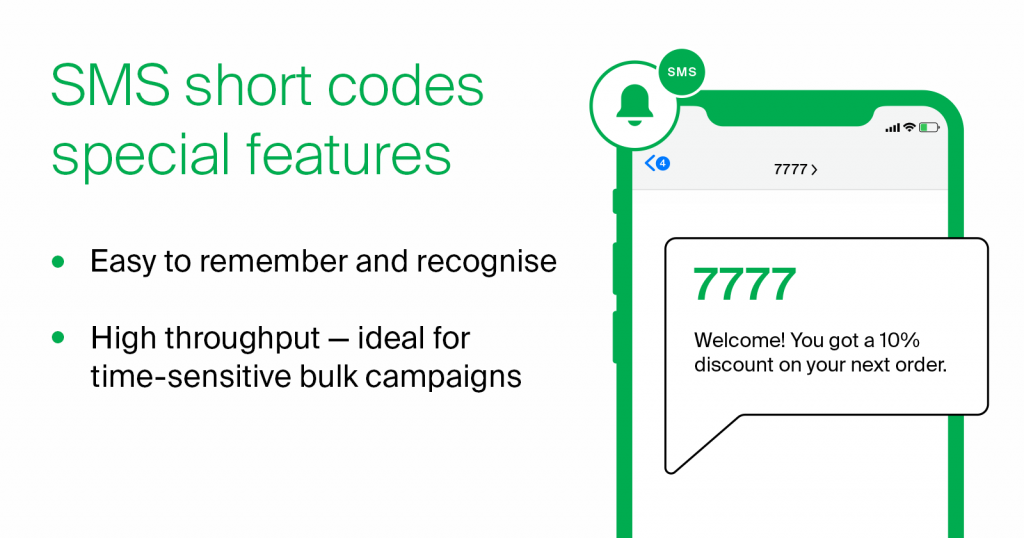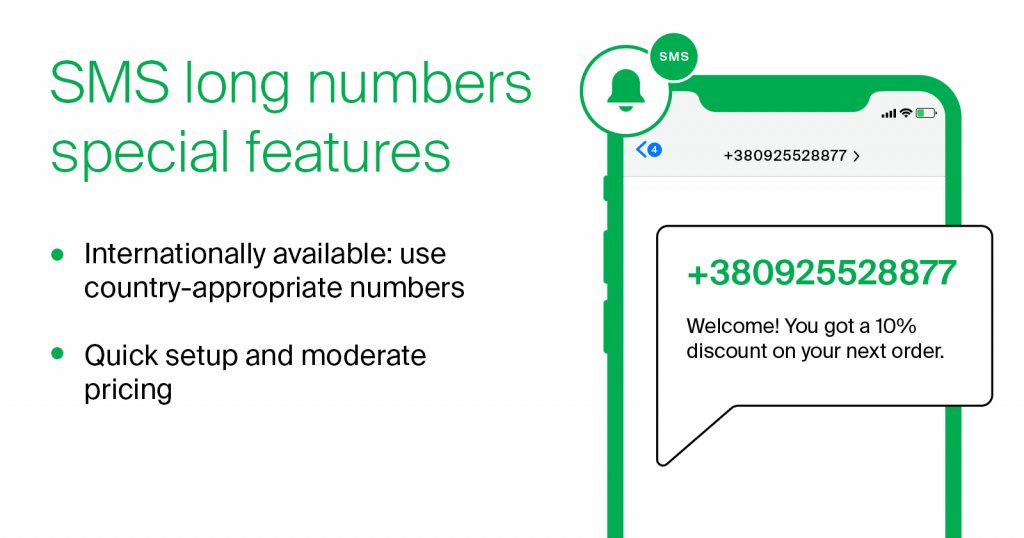Despite the rapid technological advances of the recent decades, maintaining a dialogue with certain audience segments can still be a challenge for brands. Your customers could be using a basic device that does not support rich messaging capabilities, or they could be based in an area that lacks proper connectivity.
Fortunately, SMS remains a valuable communication channel that allows enterprises to reach out to and even engage their audience in a dialogue virtually anywhere, requiring as little as a simple handset and GSM coverage.
To make this possible, enterprises have to invest in either a short code or a long number, depending on their business needs. In this article, we will learn what short codes and long numbers are, what benefits they bring to enterprises and consumers, and the actual differences between the two, other than the mere length.
So, what are short codes and long numbers?
Short codes are shorter phone numbers, typically around 3-4 digits long, which enterprises can use for bulk SMS messaging and two-way communication with their customers. Short codes are easy to remember and have the added benefit of high throughput, allowing brands to send scores of messages every second. If you have a dedicated short code, you can also choose to boost your brand recognition and marketing by using a vanity short code, customising all the numbers to make your short code as memorable as possible.

Long numbers are 10-12-digit phone numbers with an area code. They are also known as virtual mobile numbers. With a long number, the enterprise can use the same number to send SMS messages and place calls, establishing a consistent channel for all forms of customer communication. A message that comes from a standard-length number feels like it is coming from a person, not a bot, which makes long numbers great for providing a personalised customer service experience.
While long numbers allow you to set up a designated number for every region your company operates in, they can be suboptimal for sending bulk campaigns because of low throughput.

The benefits and applications of short codes and long numbers
Brand recognition
Whether you use a short code or a long number, it becomes central to your brand’s text communications. Short codes and long numbers contribute to your business’ recognition, helping maintain a consistent brand image across platforms and channels.
While the short codes are generally easier to recognise at a glance, long numbers tend to be more engaging. Users are more likely to reach out via a long number as they subconsciously associate these with real human contact.
Bulk messaging and SMS customer service
As mentioned above, short codes are the best fit if you want to send thousands of messages in an instant. Bulk messaging allows brands to cover a broad audience within mere seconds. Additionally, SMS is much more affordable for engaging thousands of consumers at once, compared to other marketing options, like purchasing ads.
At the same time, both types of numbers allow for a great degree of customisation and two-way conversations. Two-way communication and targeted marketing messages provide users with a personalised touch, while bulk campaigns and automated messaging cover all your text marketing needs.

Chief Global Enterprise Officer
Short codes and long numbers are fantastic tools that can help your business efficiently communicate with the audience in a wide variety of scenarios. While the short codes are great for instant brand recognition, long numbers help building trust by using the regional codes of the markets you are operating in.
Domestic and international messaging
A choice between a short code and a long number quite often depends on the target brand’s audience and desired geographic reach.
- Short codes allow brands to only send and receive messages nationally, and are only suitable for domestic business messaging and communications.
- Long numbers can help scale the business and enable enterprises to reach out to the audience regardless of their location. With a long number, an enterprise can message customers internationally and even use the local code to make the communication feel more trustworthy.
Engaging the consumers
Despite short codes and long numbers having a fair share of differences, they can play very similar roles when it comes to customer engagement. You can use short codes and long numbers to gain traction with your consumers since both number types are well-suited for purposes like delivering critical alerts and personalised reminders, as well as replying to customers’ inquiries. This flexibility allows the brands to meet their consumer needs without using different communication channels. Additionally, real-time message traffic reports give enterprises valuable user insight for optimising their campaigns and further increasing engagement.
You can also go beyond advertising by facilitating other marketing initiatives like competitions, quizzes and rewards programmes. An increasing number of TV and radio shows are using both code types to enhance audience engagement. As discussed previously, a short code would be a perfect solution for a domestic market, while the long number will help you cover an international audience.
Donations
Short codes and long numbers can be a great aid in running charity campaigns or gathering other types of donations. Since they can be billed at custom rates, mobile subscribers can donate directly from their phones without a need for banking applications and internet connection. This makes donating quicker, easier and more accessible for users all over the globe.
When to use…
…a short code
Short codes are an excellent SMS marketing tool for sending bulk messaging campaigns. Other common uses include:
- If you need to text thousands of people at once for emergency alerts
- If you are looking to conduct a dialogue with a domestic audience
- If you are planning to run national surveys, quizzes, etc.
…a long number
While less suited for mass messaging, a long number is a great choice for brands looking to expand their international presence without sacrificing the fantastic open and engagement rates of SMS. Here are a few instances in which long code comes in handy:
- If you are looking for a dialogue with an audience worldwide
- If you want to add a more “human” feel to your communications
- If you are looking for moderate pricing
In conclusion
Despite its respectable age, SMS is still going strong as a ubiquitous communication channel that can help enterprises engage and support their audience around the globe. The use of short codes and long numbers can help facilitate this process with 2-way capabilities, ensuring that the consumers with the most basic handsets can receive top-notch support.
To make the most of both number types, however, it is vital to figure out your exact circumstances, financial limitations, and campaign scale. Whether you require instant recognition or seek to win the trust of the consumers abroad, GMS experts would gladly come to your aid, tailoring the offer to your exact needs. Contact us today and bring your customer communication to a brand-new level.

